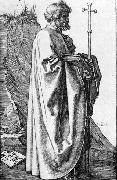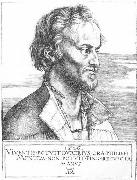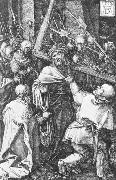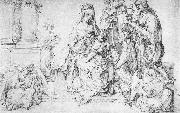
|
Artists
Index
|
||
|
Albrecht Durer
|
||
|
Willibald Pirckheimer new21/Albrecht Durer-474396.jpg Gemälde IDENTIFIZIERUNG:: 63624 |
1524 Engraving, 181 x 115 mm Metropolitan Museum of Art, New York The celebrated humanist Willibald Pirckheimer, counselor to the Emperor, friend of Erasmus of Rotterdam, member of the Nuremberg city council, translator of Greek and Latin classics, commander of the Nuremberg contingent of troops in the Swiss War, was Albrecht D?rer's closest friend and mentor. Suffering from severe gout, Pirckheimer had retired from the city council shortly before D?rer engraved this portrait. The copper plate portrait is an example of the new portraits he created using printed graphics. The bust is placed, like a monument, above an inscription that reads like an epitaph. It refers to the contributions and character of Pirckheimer, and the inscription beneath the portrait reads: "Image of Willibald Pirckheimer at age 53. Man lives through his intellect; all else will belong to death. 1524" (based on Livy III, 36). In this likeness, too, D?rer could not resist the temptation to show the reflection of windows in the eyes. The magnificent bulldog head of D?rer's best friend is not so much embellished as transfigured. Mass is converted into energy, and the heavy features of the learned irascible giant appear illumined, as it were, by the enormous eyes which flare from their sockets like powerful searchlights. This engraving was used as a bookplate by Pirckheimer. Many volumes containing it, formerly in the possession of the Royal Society, were sold at auction in London in 1925. Until 1945 there was an impression on white satin, probably posthumous, at Bremen.Artist:D?RER, Albrecht Title: Willibald Pirckheimer Painted in 1501-1550 , German - - graphics : portrait | |
| |
|
|
|
|
||
|
St Philip new21/Albrecht Durer-732734.jpg Gemälde IDENTIFIZIERUNG:: 63625 |
1526 Engraving, 122 x 76 mm Metropolitan Museum of Art, New York St Philip was crucified in the reign of Emperor Domitian. This is the fifth and last sheet of the unfinished series of Apostles. The great white mantle pleased D?rer so much that he used it again in his painted panels of Four Apostles in 1526. The handling is very bold and shows the skill due to the absolute command of the graver. The long sweeping lines which marked D?rer's earlier work, as St Jerome in Penitence, reappear, especially in the background. This work was apparently finished in 1523, based on the preparatory drawing bearing that date.Artist:D?RER, Albrecht Title: St Philip Painted in 1501-1550 , German - - graphics : religious | |
| |
|
|
|
|
||
|
Philipp Melanchthon new21/Albrecht Durer-337899.jpg Gemälde IDENTIFIZIERUNG:: 63626 |
1526 Engraving, 174 x 127 mm Museum of Fine Arts, Boston Philipp Melanchthon (1497-1560) was one of the great humanists of his age. He was the German author of the Confession of Augsburg of the Lutheran Church (1530), humanist, reformer, theologian, and educator. His original name Philipp Schwartzerd means Black Earth in German, in Greek, Melanchthon. After studying in Heidelberg and T?bingen, he taught as a professor in Wittenberg. The main emphasis of his research was on theology, philosophy and rhetoric. In 1521 Melanchthon published the Loci communes, the first systematic treatment of evangelical doctrine. Because of his academic expertise he was asked to help in founding schools, and he virtually reorganized the whole educational system of Germany, founding and reforming several of its universities. In November 1525 and May 1526 he visited Nuremberg at the invitation of the city council in order to establish the first public school. Melanchthon is facing to the right in a striking three quarter profile. The epitaph-like Latin inscription refers to the humanist discussion Melanchthon led on the portrayability of the human character: "1526. Viventis potuit Dvreris Ora Philippi Mentem non Potuit Pingere Docta Manus" (1526. D?rer was able to draw the features of Philipp from life, but his expert hand could not capture his spirit. A.D.). It can be pointed out that the reflection of a window in the eyes verges on the ridiculous in this case, as the indication of clouds in the background show that Melanchthon is supposed to be standing in the open air.Artist:D?RER, Albrecht Title: Philipp Melanchthon Painted in 1501-1550 , German - - graphics : portrait | |
| |
|
|
|
|
||
|
Bearing of the Cross new21/Albrecht Durer-642735.jpg Gemälde IDENTIFIZIERUNG:: 63627 |
1512 Engraving, 117 x 74 mm Art Museum, Princeton Sheet No. 10 of the Engraved Passion. St Veronica is shown kneeling in front of Christ. This engraved version cannot compare to the triumphant one of the woodcut. In this instance, Christ is pictured standing, turned toward the women. The rendering of this scene as a nocturne is unprecedented. This print can be called "Schongaueresque" in concept. The guardsman shouting at the people is, in fact, found in Schongauer's version, perhaps based on Passion plays. There is an impression without the hanger of the tablet bearing the monogram at the Museum of Fine Arts in Boston.Artist:D?RER, Albrecht Title: Bearing of the Cross (No. 10) Painted in 1501-1550 , German - - graphics : religious | |
| |
|
|
|
|
||
|
The Virgin with Two Angels and Four Saints new21/Albrecht Durer-553228.jpg Gemälde IDENTIFIZIERUNG:: 63628 |
1521 Pen, 252 x 387 mm Mus?e Cond? Chantilly The four saints are St Catherine, St John the Evangelist, St James the Great and St Joseph. This drawing, which is cut at the top, is to be considered as a study for a large painting. It is an example of the new freedom of arrangement on an architectural basis.Artist:D?RER, Albrecht Title: The Virgin with Two Angels and Four Saints Painted in 1501-1550 , German - - graphics : study | |
| |
|
|
|
|
||
| Vorheriger Künstler Nächster Künstler | ||
|
Also Buy::. For Following Paintings / Artists / Products, Please Use Our Search Online: |










